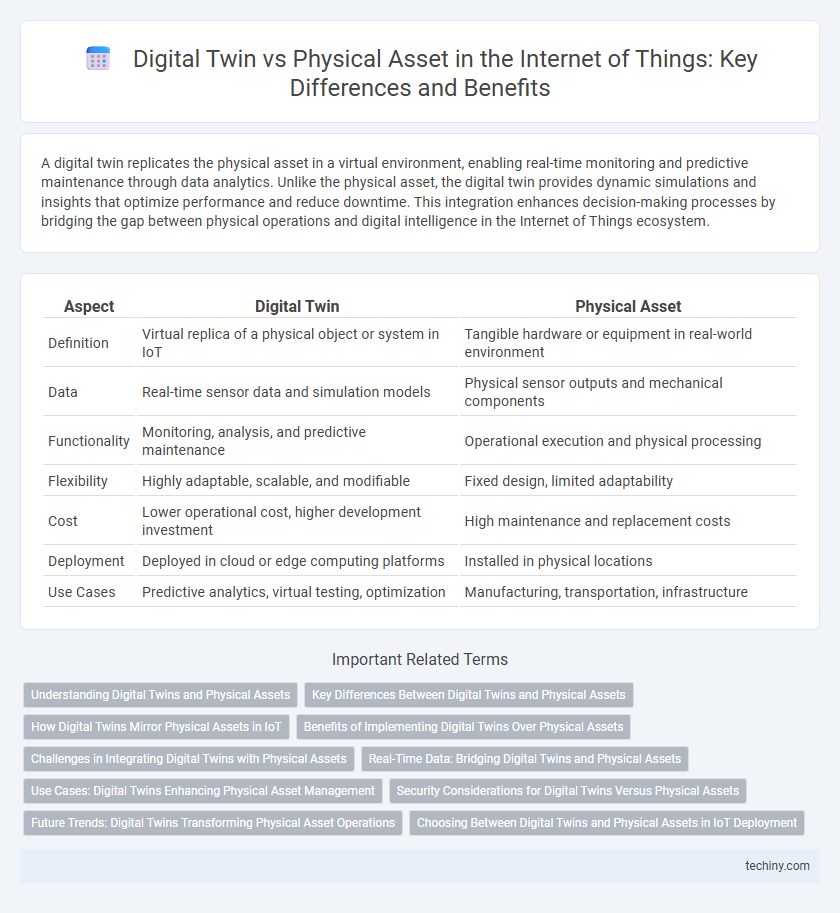A digital twin replicates the physical asset in a virtual environment, enabling real-time monitoring and predictive maintenance through data analytics. Unlike the physical asset, the digital twin provides dynamic simulations and insights that optimize performance and reduce downtime. This integration enhances decision-making processes by bridging the gap between physical operations and digital intelligence in the Internet of Things ecosystem.
Table of Comparison
| Aspect | Digital Twin | Physical Asset |
|---|---|---|
| Definition | Virtual replica of a physical object or system in IoT | Tangible hardware or equipment in real-world environment |
| Data | Real-time sensor data and simulation models | Physical sensor outputs and mechanical components |
| Functionality | Monitoring, analysis, and predictive maintenance | Operational execution and physical processing |
| Flexibility | Highly adaptable, scalable, and modifiable | Fixed design, limited adaptability |
| Cost | Lower operational cost, higher development investment | High maintenance and replacement costs |
| Deployment | Deployed in cloud or edge computing platforms | Installed in physical locations |
| Use Cases | Predictive analytics, virtual testing, optimization | Manufacturing, transportation, infrastructure |
Understanding Digital Twins and Physical Assets
Digital twins are advanced virtual models that replicate the real-time status, condition, and behavior of physical assets using IoT sensors and data analytics. These digital counterparts enable predictive maintenance, performance optimization, and remote monitoring, reducing downtime and operational costs. Physical assets, such as machinery or infrastructure, serve as the tangible entities whose data streams feed into digital twins, creating a dynamic link between the physical and digital worlds.
Key Differences Between Digital Twins and Physical Assets
Digital twins are virtual replicas of physical assets that enable real-time monitoring and predictive analytics through continuous data synchronization, whereas physical assets are the actual tangible objects being replicated. Digital twins facilitate enhanced operational efficiency and proactive maintenance by simulating different scenarios without risking the physical asset. Physical assets require manual inspection and maintenance, leading to higher downtime and less flexibility compared to their digital counterparts.
How Digital Twins Mirror Physical Assets in IoT
Digital twins create precise virtual replicas of physical assets by integrating real-time sensor data, enabling continuous monitoring and predictive maintenance in IoT environments. These digital representations capture the asset's current state, operational behavior, and environmental conditions to optimize performance and reduce downtime. By mirroring the physical asset's lifecycle, digital twins enhance decision-making and streamline asset management across complex IoT ecosystems.
Benefits of Implementing Digital Twins Over Physical Assets
Digital twins offer real-time monitoring and predictive maintenance capabilities that physical assets alone cannot provide, significantly reducing downtime and operational costs. They enable enhanced data-driven decision-making by simulating asset performance under various conditions without risking damage to the actual equipment. The integration of digital twins with IoT sensors facilitates continuous optimization and improved lifecycle management of physical assets.
Challenges in Integrating Digital Twins with Physical Assets
Integrating digital twins with physical assets presents challenges such as data synchronization discrepancies, real-time communication latency, and security vulnerabilities impacting IoT ecosystems. Ensuring accurate sensor data collection and seamless interoperability between diverse IoT devices requires robust architectures and standards. Addressing these issues is critical for effective predictive maintenance, operational optimization, and holistic asset management in industrial IoT deployments.
Real-Time Data: Bridging Digital Twins and Physical Assets
Real-time data synchronization enables digital twins to mirror physical assets with high fidelity, allowing for immediate monitoring and predictive maintenance. Sensors embedded in physical assets continuously transmit operational data, which digital twins use to simulate current conditions and forecast potential issues. This seamless data exchange enhances decision-making, reduces downtime, and optimizes asset performance across industrial IoT environments.
Use Cases: Digital Twins Enhancing Physical Asset Management
Digital twins enable real-time monitoring and predictive maintenance of physical assets by creating dynamic, virtual replicas that simulate operational conditions. This technology enhances asset management through improved anomaly detection, lifecycle optimization, and efficient resource allocation. Leading industries such as manufacturing, energy, and transportation leverage digital twins to reduce downtime and optimize performance.
Security Considerations for Digital Twins Versus Physical Assets
Digital twins require robust cybersecurity measures to protect data integrity and prevent unauthorized access, given their reliance on real-time data exchange and network connectivity. Physical assets are vulnerable to traditional security threats such as theft, tampering, or environmental damage but lack exposure to cyberattacks faced by digital counterparts. Implementing encryption protocols, continuous monitoring, and access controls is critical to safeguarding digital twins and ensuring synchronized security with their physical assets.
Future Trends: Digital Twins Transforming Physical Asset Operations
Digital twins are revolutionizing physical asset operations by enabling real-time monitoring, predictive maintenance, and enhanced decision-making through continuous data synchronization between digital models and actual assets. Advanced IoT sensors and AI algorithms will drive the evolution of digital twins, fostering greater operational efficiency and reduced downtime in industries such as manufacturing, energy, and transportation. Future trends indicate a stronger integration of digital twins with edge computing and 5G networks, amplifying responsiveness and scalability in asset management systems.
Choosing Between Digital Twins and Physical Assets in IoT Deployment
Choosing between digital twins and physical assets in IoT deployment depends on the need for real-time simulation versus tangible operation. Digital twins enable continuous monitoring, predictive maintenance, and scenario testing without disrupting physical systems, offering significant cost savings and operational efficiency. Physical assets remain essential for actual production and interaction within environments, particularly where digital models cannot fully replicate complex, unpredictable real-world conditions.
digital twin vs physical asset Infographic

 techiny.com
techiny.com